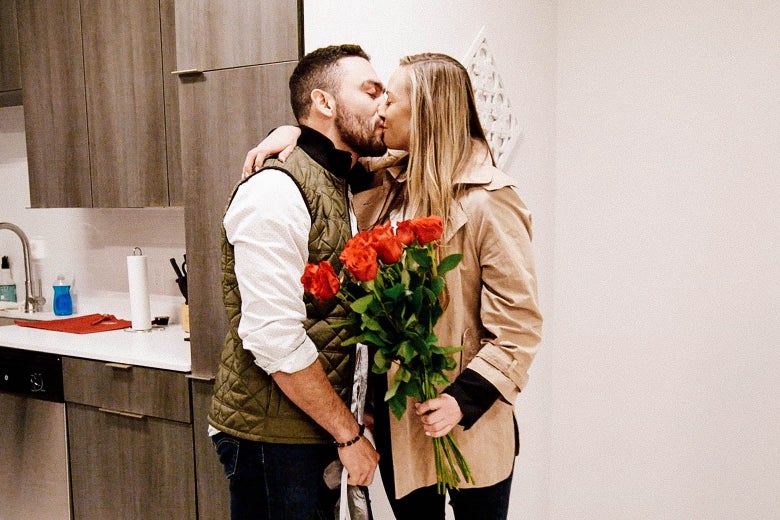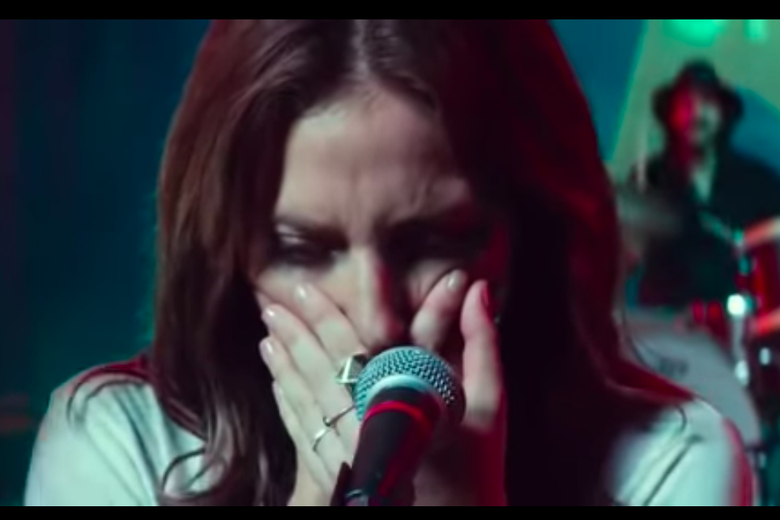I Can’t Watch Any Show or Movie Now Without Thinking About Social Distancing – Slate

Jessica and Mark on Love Is Blind aaaaaaaaaaghhhhhh.
Netflix
The “talking through a wall” thing was supposed to be the strange part of Love Is Blind, the Netflix reality show that debuted 100 years ago, which is to say, in mid-February of this year. The show’s first episodes feature the contestants isolated in sets decorated like small living rooms, talking to one another through a kind of scrim. This is meant to be a bizarre twist on normal life: These nubile young dodos are supposed to make emotional connections without seeing or touching each other?! Those who managed to fall in love and get engaged, sight unseen, were then permitted to meet in person and begin their normal lives together.
By the time I finally started watching the show last week, however, the pods looked mercifully safe. It was the Mexican vacation that followed—the airports, the sprawling group dinners—that looked terrifying. After that, it got even worse: The contestants all moved into the same apartment complex, where they passed the time playing beer pong, making out, and touching surfaces.
New public health mandates have profoundly changed the experience of watching TV and movies, for me at least—even as watching TV and movies has become basically the only way to pass the time. As it turns out, a whole lot of televised entertainment is about people interacting with one another! That means I can no longer watch just about any story on any screen without recoiling instinctively in horror and judgment. A child hugging his grandma in a pharmaceutical commercial: a menace! The final dance in Footloose: an abomination, just as the uptight adults warned. All those crowd scenes in The Hunger Games series: the real travesty of public leadership.

Lady Gaga, stop touching your faaaaace!
Warner Bros.
The most glaring triggers come from scenes of casual, unthinking human intimacy. For example, when Lady Gaga’s character gets her big break in A Star Is Born, she does the following, in this order: covers her entire face in embarrassment, breathes one inch from one microphone, walks over to another microphone, holds it with her hands, presses her hands over her mouth, and then sings directly into Bradley Cooper’s face from two inches away. And only now have I realized how many shows and movies feature crowd scenes: teeming stadiums of Taylor Swift fans in Miss Americana, the huge Corleone family wedding in The Godfather, the glorious Chicago parade toward the end of Ferris Bueller’s Day Off.
When you spend your entire day thinking about social distancing, every genre is horror. The Two Popes are both old and should not be socializing. The Bachelor is a show about people wiping away tears from their eyes. Joker follows a man who frequents grimy comedy clubs and then comes home to his elderly mother. Four Weddings and a Funeral? More like Five Events That Really Should Have Been Postponed. Fleabag is about a woman who falls in love with a potential disease vector. The orgy in Eyes Wide Shut? At least they’re all wearing masks.
The Two Popes are both old and should not be socializing.
It’s amazing how quickly our brains can rewire themselves to fear a new danger. The virus has inverted our usual signifiers, turning ostensibly peaceful scenes tense, and vice versa. The Scandinavian murder rituals in Midsommar are scary in the usual fashion—but at least they’re outside most of the time! Meanwhile, a crowded grad school party before the action even begins has suddenly become a scene of deeper horror. Pagans with weapons are frightening, but a roomful of blithe twentysomethings jostling around feels more urgently dangerous.
Relief can only be found, perhaps, in shows and movies about people who are reassuringly isolated: All Is Lost, featuring Robert Redford, and no one else, on a boat. Gravity, in which Sandra Bullock and George Clooney are stranded in space, safely ensconced in thick protective suits. And Castaway, a movie about Tom Hanks dutifully learning to live apart from civilization—at least until the time is right to return.
Let’s block ads! (Why?)


